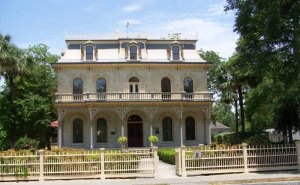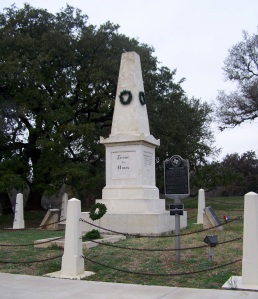But Jack Slade was not quite dead. Some stories have it that he looked up at Jules Beni and gasped, “I’ll live long enough to hang your ears from my watch chain!†The two stage drivers carried him into the station and laid him in a bunk. Almost before the smoke had cleared, a westbound stage pulled into Julesburg, carrying Slade’s immediate boss, the operations superintendent on his own tour of inspection. Accounts differ on what happened to Jules Beni upon being arrested by the outraged operations superintendent. Without provocation, Jules Beni had gunned down an unarmed man in front of witnesses. Anyway it was sliced on the frontier; it came out as cold-blooded murder. Although Jack Slade was still breathing, everyone seemed fairly certain he wouldn’t continue to do so for long. Beni was hung from an improvised gallows and half-strangled; either the rope broke and he managed a daring getaway, or the superintendent ordered him let down and extracted a promise that he would depart immediately and at speed, and stay the hell away from the division. The Pony Express had a real-time test, as one of the newly-hired riders was sent galloping hell for leather to the Army post at Fort Laramie two hundred miles away – the nearest place to find a doctor.
The Army surgeon was probably astonished to find Jack Slade still alive. Before antibiotics and sterile surgery, a non-fatal bullet wound was a serious matter, even when bones, the abdominal cavity or vital organs were not involved. Infection, sepsis, gangrene; all could kill in slow-motion and with a great deal more agony. The military doctor extracted some of the lead balls and fragments … and Jack Slade hung on well enough to be moved to his home station, and later to St. Louis for another round of surgery. He was back at work as on the division … even as Russell, Majors and Waddell sold out to Ben Holladay. Holliday was known as the stagecoach king; a businessman whose personal flamboyance was only equaled by his drive and shrewd, far-sighted sense, in running extensive stagecoach lines in California. With Holladay, Jack Slade would be on his third employer in as many years, all in more or less the same place, and performing the same duties.
Meanwhile, Jules Beni hid out with local Indian tribes and then settled on a new road ranch, some hundred miles east of Julesburg. Having done his best to kill Slade, and fled that part of the Platte Valley which was under Slade’s authority – he had spent the time since then unmolested, and growing bolder. He had a herd of cattle pastured on property that he owned within Slade’s division, and he came to get them, boasting that he was not afraid of Slade, that Slade had no power over him – and if Slade didn’t kill Jules, Jules would kill him. For some weeks, Jack Slade managed to avoid a direct encounter. He consulted with the officers at Fort Laramie regarding the threat which Jules Beni posed – not only to him personally, but to general peace, law and order in the area. He had their acquiescence, as about the only duly anointed civil authorities in the district, to do what everyone agreed best; kill Beni. He dispatched four of his own men on horseback to the area where Beni was said to be, promising a reward of $500 if he was captured alive. A day or so later, Jack Slade was traveling by coach between two stations, when two of the men whom he had sent flagged down his coach. They were greatly excited – they had captured Jules Beni after a brief exchange of bullets and blows at a neighboring ranch; they had tied him over a pack-saddle and brought him to Cold Spring station, just ahead. Presently, he was tied up to a post in the corral at the Cold Spring station, awaiting Slade’s arrival and judgement.
There are two versions of what happened, when Jack Slade arrived at Cold Spring Station, and inspected Jules Beni – the man who had done his best to murder him in cold blood a little over a year before. One is prosaic: Beni had been wounded in the gunfight, and died of shock and loss of blood. Slade’s men would miss out on the reward, so they tied up the corpse and insisted that he was alive – but playing possum. Slade answered, “I’ll see who’s playing possum,†and cut off one of Beni’s ears. No movement at all, and Slade continued, “That proves it, but I might just as well have the other ear.†The other version, a frontier Grand Guignol spectacle, luridly embroidered upon for years afterwards, had Jules Beni still alive, tied to the corral post and Jack Slade snarling, “You made me suffer, now I’ll try to pay you for it.†That version had Slade shooting Jules Beni at short range in non-vital places, retiring between shots for a stiff drink, and then returning for another shot. Other versions had Slade taunting the dying man by telling him to write up his will, or saying in response to Beni’s plea to see his wife one last time, “When you shot me, you gave me no chance to see my wife… so now take your medicine.†When the tormented Beni finally expired – a by-then-very-drunken Jack Slade sliced off the ears and put them in his vest-pocket. He carried at least one of the severed, dried ears for the rest of his life and his reputation as the ultimate hard man of the Central Overland was cemented into frontier legend. The following day, he surrendered to the authorities at Fort Laramie and requested investigation of the incident – they did not press charges, and he was released.
In 1862, Ben Holladay had bought out the Overland completely at a fire-sale price and renegotiated the mail contract with the government. This involved moving the stage road – with all of the stations which supported it – from the line of the North Platte, to a new route along the South Platte, through present-day Greeley, Colorado, and the mining settlements established in the Black Hills. This route bypassed Fort Laramie, shortened the total time it took to cross half a continent and removed stage-line personnel and travelers from what had become a dangerous war zone from raiding Indians. To carry this out, with minimal disruption to service represented a herculean effort on the part of Central Overland managers and superintendents. Unfortunately, the move of the route to more inhabited regions put the increased temptation of drink in the way of Jack Slade … to his misfortune. The soft-spoken and polite aspect of his demeanor was utterly vanquished when he drank. It was truly a Jekyll and Hyde personality change. When sober, Slade may have been impatient with incompetence and dishonesty in subordinates, but mild-spoken, cordial to travelers and professional to his superiors. Drunk, he became as dangerous and as uncontrollable as a coiled rattlesnake. His binges increased in frequency and in violence, even though he customarily apologized afterwards and paid the damages. In the course of a particularly violent spree late that year, however, he and some friends shot up the sulter’s store at Fort Halleck, which brought down the wrath of the Army. The Central Overland’s lawyer bargained away the charges by agreeing to dismiss Slade.
Still fit, and with a reputation as a trustworthy and reliable wagon-master, he gravitated into hauling freight to the Wyoming gold-rush town of Virginia City. In March of 1864, he was hanged in public by vigilantes there, after a particularly drunken and violent spree. There have been conflicting reasons for them having done this. Other offenders executed by the vigilantes had committed murder, been a part of an organized criminal gang. Jack Slade was no more than a violent and belligerent drunk, and perhaps more feared than others of that temperament because of his reputation – a much-exaggerated reputation that had enhanced his authority in a dangerous place at a dangerous time. But perhaps the citizens of Virginia City were tired of wrecked saloons and shot-out windows, and wanted to serve notice on the most egregious offender in that line as a means of serving notice on the others. The drunken binges were what came to minds of citizens – not the work that he had done to expedite the Pony Express and keep the stagecoaches running. What had he done for them lately? So, he was hanged by the neck until dead, barely into his thirties. His wife, who was sent for but arrived too late to see him alive, later took his body to Salt Lake City for burial as soon as the spring thaws opened up the roads out of Virginia City … ironically, Joseph Alfred Slade’s body was preserved in a tin-lined coffin filled with alcohol.



